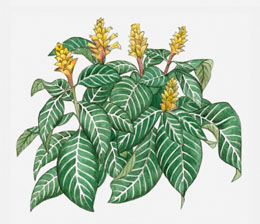Native to the forests of Brazil, 'Aphelandra squarrosa' is commonly known as zebra plant, which is widely grown for ornamental purposes. Here is a brief overview about this plant.

The zebra plant is a woody shrub that derived its name from the white stripes on its dark green leaves. It is also known as 'saffron spike' because of its saffron-yellow spike. This plant belongs to the genus
Aphelandra and family
Acanthaceae, which consists of around 2500 species.
General Characteristics
The zebra plant is popular for its foliage and colorful spikes. The stem of the plant has a purple-tinge, and the dark green leaves are waxy. The oval-shaped leaves with pointed tips, are borne in pairs (located exactly opposite to each other). The bright green leaves have midribs and veins, which are creamy white in color. Four-sided yellow spikes formed at the terminal end of the stem, produce flowers. The spike has overlapping bracts and protruding yellow flowers. These two-lipped flowers have a short lifespan, but the bract survives for almost six to eight months. Once the bract shows signs of deterioration, it has to be removed.
Zebra Plant Care
These plants need bright light to grow, but avoid keeping them in direct sunlight. Other factors essential for the growth of this plant are good airflow, high humidity and consistent moisture. Too much or too little watering can cause the leaves to fall. Ideal temperature for this plant is 65 to 70°F, and it is detrimental to expose it to a temperature below 65° F for a long period. Low temperatures cause falling of leaves in these plants. If the air inside the room is very dry, use a humidifier. 40 to 80 percent humidity must be maintained. Otherwise place the pot on a tray with some pebbles and water. You may also keep the plant in the bathroom, for satisfying its humidity requirement.
Usually, this plant blooms during the fall, but when exposed to proper conditions (a particular amount of sunlight and good growth), flowering can happen in any other season. After flowering, prune the plant to control its growth and to promote formation of side shoots. New plants can be developed from these cuttings. During winter, this plant needs water and fertilizers in small amounts only. In other seasons, you can feed them once or twice a month. You may use insecticides and fungicides to prevent attack of mealybugs, aphids, scale and spider mites, and fungal diseases that may develop during damp climate. For a good growth, zebra plants have to be grown in organic and fast draining soil.
Growing zebra plant is an easy task. A little effort is needed to take care of this beautiful plant. If the plant does not flower, its foliage is sufficient for ornamental purposes.






 The zebra plant is a woody shrub that derived its name from the white stripes on its dark green leaves. It is also known as 'saffron spike' because of its saffron-yellow spike. This plant belongs to the genus Aphelandra and family Acanthaceae, which consists of around 2500 species.
The zebra plant is a woody shrub that derived its name from the white stripes on its dark green leaves. It is also known as 'saffron spike' because of its saffron-yellow spike. This plant belongs to the genus Aphelandra and family Acanthaceae, which consists of around 2500 species.